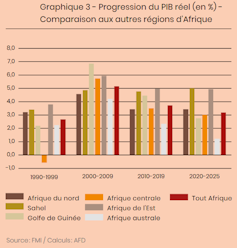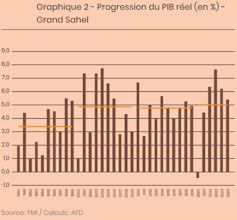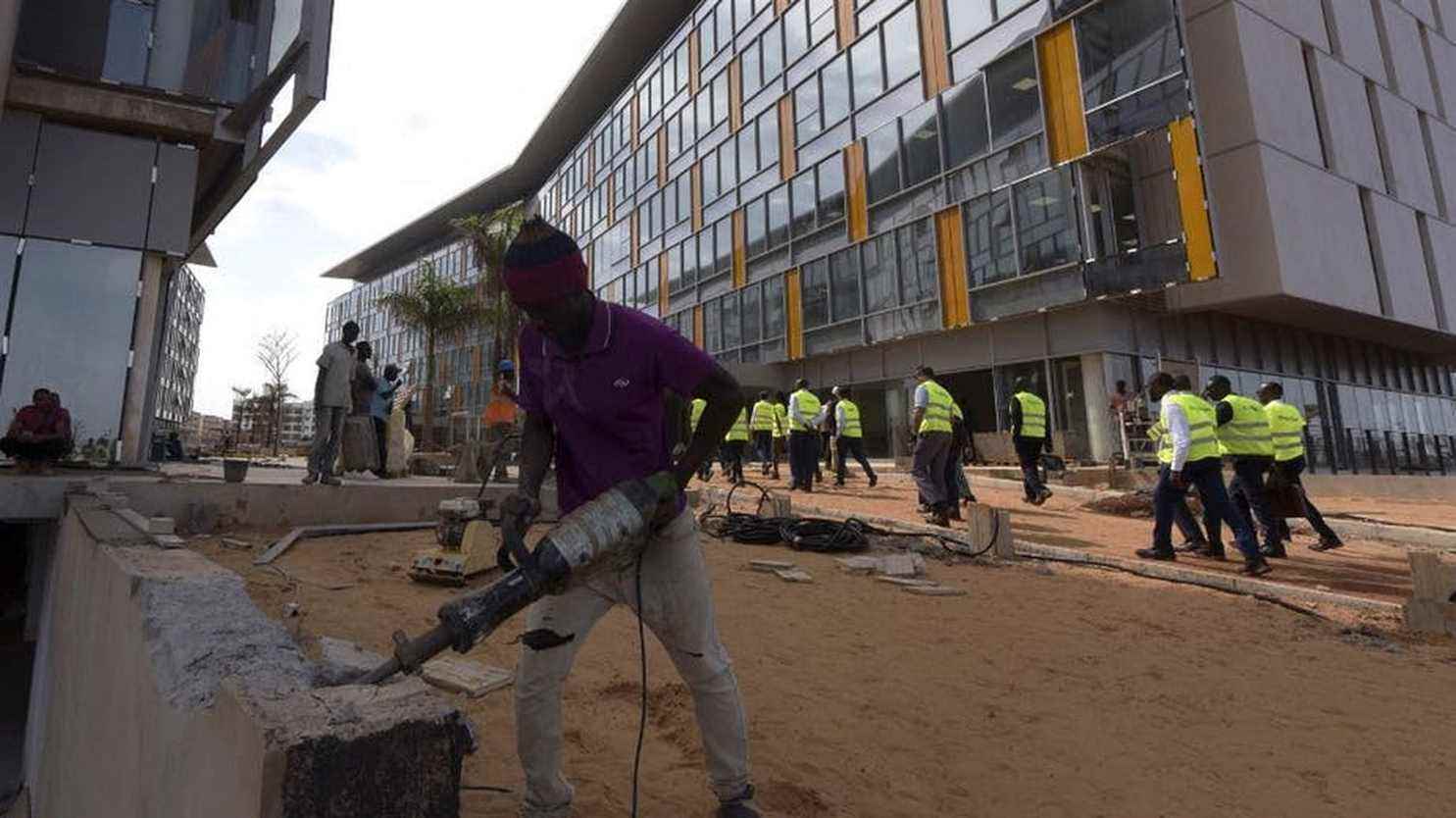If the Sahel remains in the grip of recurring conflicts, the countries of the region are nonetheless experiencing positive dynamics in terms of economic and social development.
Assessing these favorable developments, such as persistent vulnerabilities, is essential to better understand the region’s development trajectory and identify the challenges to be met.
Measured by the United Nations through their Human Development Index (HDI), the efforts of Sahelian states in favor of development are notable. The HDI has risen sharply in the Sahel since the 1990s: + 1.9% per year on average, or three times more than at the global level.
Among the dimensions of development captured by this index, the health of populations has significantly improved: life expectancy at birth has thus increased from an average of 49 years in 1990 to 61 years in 2018.

Another component of the HDI, per capita income has also increased significantly (by around 67% compared to 1990) and, at the same time, the extreme poverty rate has fallen (from 75% in the 1990s to 41%). % in 2018). The increase in wealth could therefore benefit the poorest as well.
Read also: The “invisible” of the health system in Senegal
Despite this, the countries of the region are still poorly positioned in the latest HDI ranking (in the last thirty places for the most part). The effort is therefore not complete to strengthen the still very fragile health systems of the region, in particular access to maternal health care, and to fight against recurring phenomena of undernourishment (which affects one in every person). five in the Sahel) and malnutrition (which affects a third of children under five).
In terms of wealth too, the region continues to concentrate mainly low-income countries, where progress on the poverty front has been undermined by the effects of the Covid-19 crisis.
Read also: How the Covid crisis weakened food systems in sub-Saharan Africa
But it is above all on the education front that major efforts still need to be made. Education indicators are considerably lower in the region: only one in two young people is literate (compared to more than 3 in 4 on average in Africa) and only one in three students completes secondary school.
The issue of access to education – and more broadly to basic services – is major in the region, in a context of strong demographic growth (+ 3% per year). All the more so since the rise in school enrollment rates has been accompanied by a decline in the quality of education.
The place of women in the economy would also benefit from being strengthened. While women are indeed a living force in the Sahel – playing a central role in food security and the resilience of societies – gender inequalities remain very marked and hamper their empowerment.

Thus, the region is characterized by the highest average fertility rate in the world (5.5 children per woman and 6.7 in Niger). Therefore, the Sahel could experience a doubling of its population within twenty-five years. This means that the authorities will have to make a greater effort to support the growing needs of the populations.

Sahelian GDP quadrupled between 1990 and 2020 and, also recently, the region has posted one of the highest economic growth rates in Africa (around + 4.8% per year on average since 2010).
Several factors can explain this dynamic: the good performance of certain key sectors and favorable rainfall, high investments and catch-up effects in certain sectors, the rise in the prices of extractive raw materials which are important for the region (such as gold) , the existence of areas less exposed to security issues and moderate debt (56% of GDP in 2020 against 66% across Africa).
Despite this, the structure of the Sahelian economies has changed little since the 1990s. The service sector continues to represent nearly half of added value and industry less than a quarter.
The agricultural sector remains essential, representing around 30% of added value since the 1990s and employing more than one in two Sahelians on average.

The development of agriculture is therefore crucial, to meet the major challenges of the region: economic challenge of diversification and economic transformation, food challenge in a context of strong demographic growth, social challenge in areas where social fragility and poverty require the creation of employment and added value, and environmental challenge.
In this context, the Sahelian countries remain very dependent on the outside. As the export base of these countries is not very developed and the import needs are significant, the countries of the region have on average non-negligible current account deficits (around 8% of GDP in 2017-2019).
To cover these deficits, the mobilization of external support is crucial. Thus, the Sahel is the African region receiving the most official development assistance relative to GDP (7% on average) and transfers from the diaspora are also supported (6% of GDP). The weakness of foreign direct investment, on the other hand (less than 4% of GDP), unsurprisingly reflects an unfavorable business environment.
The Sahel has been plagued by recurring conflicts since 2012, with devastating effects on the human, political, economic and social levels.
Conflicts are also weighing on public finances, due to the reduction in the tax base and the increase in military spending (nearly 9% of total spending, the highest level in Africa). Above all, the increase in military spending comes to the detriment of social and development spending, which further weakens economies due to conflicts.
In addition to the economic and social difficulties with which the Sahelian populations are confronted, these conflicts result in large part from the insufficient presence of the State in whole swathes of the territory. The capacity of the Sahelian States to provide basic public services and supervise their territories is in fact very limited overall.
In relation to the population, the number of State agents is between 3 and 10 per 1000 in Chad, Burkina Faso, Senegal, Mali and Niger against 160 in Norway for example. This is why measures to strengthen governance are fundamental.
The dynamics at work in the Sahel and the progress made in development show that the region cannot be reduced to a single zone in crisis.
But to enable the countries of the region to achieve lasting peace and development, at least five levers of action appear to be priorities: the prevention and containment of violent conflicts; improving governance; empowerment of women and girls; youth support; and support for the structuring of agricultural sectors and the development of the private sector and entrepreneurship.![]()
Yasmine Osman, Economist, AFD Africa Department, French Development Agency (AFD)
This article is republished from The Conversation under a Creative Commons license. Read the original article.
